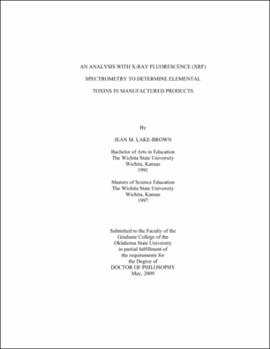| dc.contributor.advisor | Caneday, Lowell | |
| dc.contributor.author | Lake-Brown, Jean M. | |
| dc.date.accessioned | 2013-11-26T08:29:49Z | |
| dc.date.available | 2013-11-26T08:29:49Z | |
| dc.date.issued | 2009-05 | |
| dc.identifier.uri | https://hdl.handle.net/11244/7107 | |
| dc.description.abstract | Scope and Method of Study: This research was a survey of manufactured products specifically intended for oral consumption or close oral contact by children six and younger, to ascertain if elemental toxins were present and in what quantity. The toxins of interest were lead; bromine and mercury all classified as xenobiotic. The purpose of this study was to compare two groups of the aforementioned products and ascertain of there was any statistical difference at .05a. Groups were comprised of samples manufactured in the United States and "best fit" samples manufactured in other countries and subsequently imported. X ray fluorescence spectrometry (XRF) was utilized to measure bremsstrahlung radiation and calculated as (ROI) counts. | |
| dc.description.abstract | Findings and Conclusions: A one way ANOVA of fifty one pairs of edible samples yielded no significant difference at .05a. Data were skewed prompting apportionment for further analysis. Results yielded differences in subcategories, "fruit snacks " was shown to be higher than the mean for lead content and samples originating from Latin America were shown to be higher than the mean for bromine content, both were rejected by Tukey-Kramer due to small sample size. Student's t test indicated differences were present in some sub groupings. Edible sample counts in Regions of Interest (ROI) were compared to a constructed calibration curve for lead and bromine content. A linear relationship was obtained from which the concentration of both toxins could be calculated using the number of counts from standardized allowable limits. Nine edible samples were found to be significant for lead content above allowable levels at a 95% confidence level. While bromine was detected none was significant at a .05a. No mercury was detected in any sample. Discussion of results indicates apportionment yielded small sample size; therefore further study is indicated to assess toxins with a new focus. Additionally research should include (XPS) to determine the exact bromine species present as this is beyond the scope of this study. Future study should include larger sample size to represent nine edible survey items found to be significant for lead. | |
| dc.format | application/pdf | |
| dc.language | en_US | |
| dc.rights | Copyright is held by the author who has granted the Oklahoma State University Library the non-exclusive right to share this material in its institutional repository. Contact Digital Library Services at lib-dls@okstate.edu or 405-744-9161 for the permission policy on the use, reproduction or distribution of this material. | |
| dc.title | Analysis with x-ray fluorescence (XRF) spectrometry to determine elemental toxins in manufactured products | |
| dc.contributor.committeeMember | Apblett, Allen | |
| dc.contributor.committeeMember | Edwards, Steve | |
| dc.contributor.committeeMember | Bull, Kay | |
| osu.filename | LakeBrown_okstate_0664D_10267.pdf | |
| osu.accesstype | Open Access | |
| dc.type.genre | Dissertation | |
| dc.type.material | Text | |
| dc.subject.keywords | baby food | |
| dc.subject.keywords | bromine | |
| dc.subject.keywords | domestic | |
| dc.subject.keywords | imported | |
| dc.subject.keywords | lead | |
| dc.subject.keywords | mercury | |
| thesis.degree.discipline | Environmental Science | |
| thesis.degree.grantor | Oklahoma State University | |
